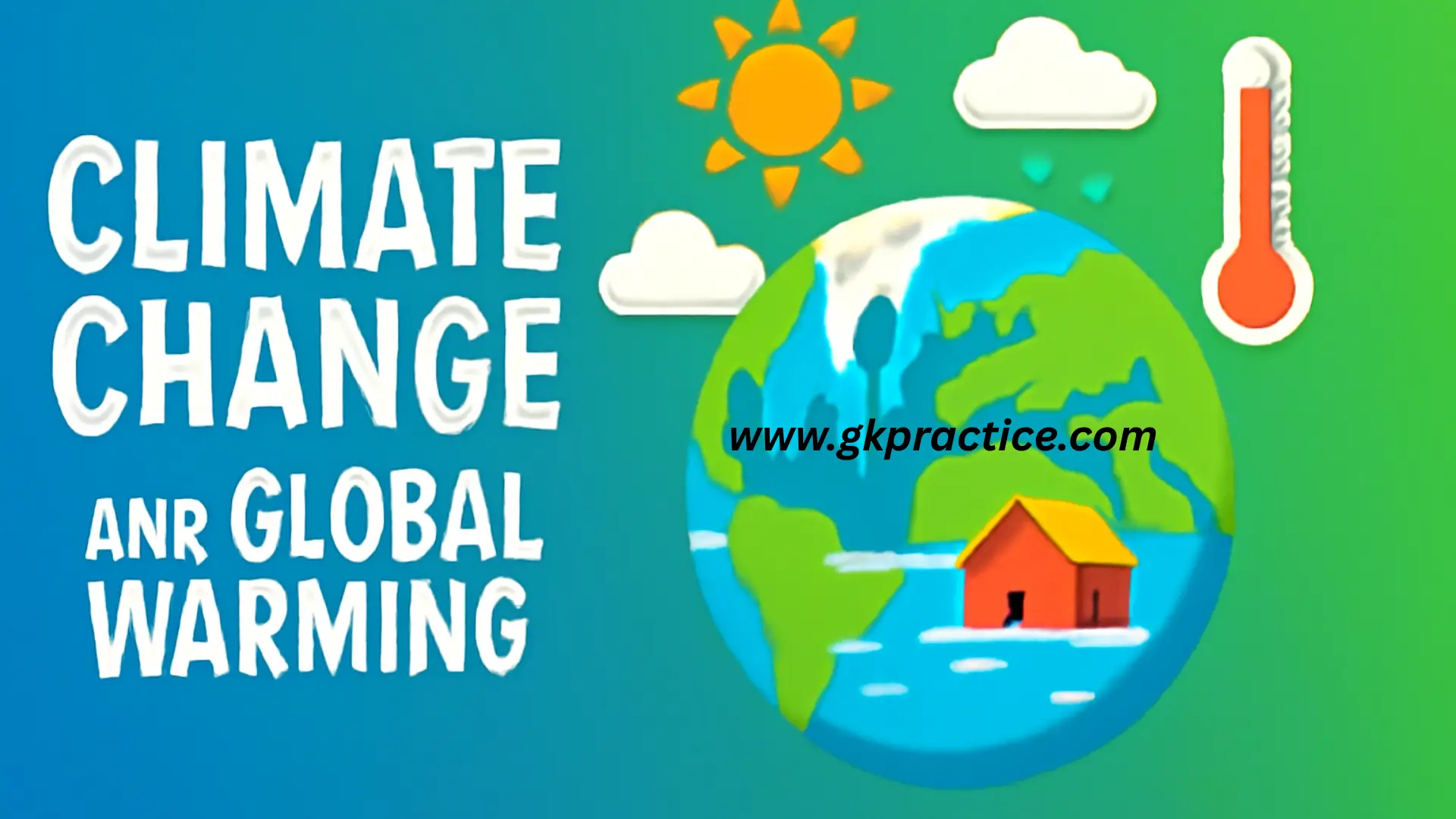Climate change and global warming are major environmental challenges affecting ecosystems, weather patterns, and human life worldwide. This article explains the key causes such as greenhouse gas emissions, deforestation, and industrial pollution, the effects including rising temperatures, melting glaciers, and extreme weather, and practical solutions to mitigate their impact. Learn how sustainable practices and global efforts can help combat climate change.
Understanding Climate Change and Global Warming With These GK Questions And Answers:
1. What is the primary cause of global warming?
A. Solar flaresB. Greenhouse gas emissions
C. Volcanic eruptions
D. Earthquakes
Explanation: Global warming mainly occurs due to excessive greenhouse gas emissions like carbon dioxide, methane, and nitrous oxide from human activities such as burning fossil fuels, deforestation, and industrial processes, which trap heat in the atmosphere and raise Earth’s average temperature.
2. Which greenhouse gas is the most abundant in contributing to global warming?
A. MethaneB. Nitrous oxide
C. Carbon dioxide
D. Ozone
Explanation: Carbon dioxide is the most significant greenhouse gas contributing to climate change. It is released mainly from burning coal, oil, and natural gas, as well as deforestation. CO₂ traps heat in the atmosphere, causing global temperatures to rise and affecting weather patterns worldwide.
3. What is the effect of global warming on glaciers?
A. Formation of new glaciersB. Melting of glaciers
C. Glaciers remain unchanged
D. Glaciers move faster
Explanation: Global warming increases Earth’s temperatures, causing glaciers and polar ice caps to melt at an accelerated rate. This contributes to rising sea levels, loss of freshwater sources, and disruption of ecosystems dependent on cold regions for survival.
4. Which human activity contributes most to greenhouse gas emissions?
A. AgricultureB. Industrial mining
C. Burning fossil fuels
D. Fishing
Explanation: Burning fossil fuels for electricity, transportation, and industrial activities releases large amounts of carbon dioxide and other greenhouse gases. These emissions intensify the greenhouse effect, leading to global warming and climate change impacts on weather, ecosystems, and human life.
5. Which international agreement aims to reduce global greenhouse gas emissions?
A. Kyoto ProtocolB. Montreal Protocol
C. Paris Agreement
D. Rio Summit
Explanation: The Paris Agreement is an international treaty signed in 2015 to combat climate change. It focuses on limiting global warming to well below 2°C above pre-industrial levels through national commitments to reduce greenhouse gas emissions and promote sustainable development.
6. How does deforestation contribute to climate change?
A. Increases oxygen levelsB. Reduces carbon absorption
C. Reduces soil fertility only
D. Promotes rainfall
Explanation: Deforestation reduces the number of trees that absorb carbon dioxide from the atmosphere. Fewer trees mean higher CO₂ levels, enhancing the greenhouse effect, accelerating global warming, and leading to loss of biodiversity and disruption of local and global climate systems.
7. What is a major effect of global warming on oceans?
A. Rising sea levelsB. Formation of new islands
C. Decrease in salinity
D. Ocean freezing
Explanation: Global warming causes polar ice caps and glaciers to melt, increasing water volume in oceans. Additionally, higher temperatures cause ocean water to expand. Rising sea levels threaten coastal communities, ecosystems, and freshwater availability worldwide.
8. Which sector is a major contributor to methane emissions?
A. TransportationB. Agriculture and livestock
C. Manufacturing industries
D. Deforestation
Explanation: The agriculture sector, especially livestock like cattle, produces significant methane through enteric fermentation and manure management. Methane is a potent greenhouse gas, with a much higher heat-trapping effect than CO₂ over a short period, contributing to rapid climate change.
9. What is a practical solution to reduce global warming?
A. Planting trees and renewable energyB. Increasing fossil fuel usage
C. Industrial expansion
D. Mining more coal
Explanation: Planting trees helps absorb CO₂, while using renewable energy like solar and wind reduces dependence on fossil fuels. Together, these strategies lower greenhouse gas emissions, mitigate climate change effects, and promote a sustainable and environmentally friendly future.
10. Which human health issue is worsened by global warming?
A. Heat-related illnessesB. Improved immunity
C. Better air quality
D. Reduced diseases
Explanation: Global warming increases the frequency and intensity of heat waves, which can cause heat exhaustion, heat stroke, and dehydration. Higher temperatures also worsen air quality, spread vector-borne diseases, and pose risks to vulnerable populations, including the elderly and children.







